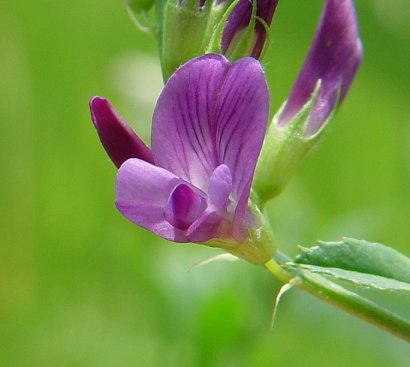Alfalfa - Medicago sativa

Common Names: Alfalfa, Lucerne, Purple Medick, Medicago sativa, Lucerne grass, Vetch, Chilean Clover, Buffalo Herb, Holy-hay, Lucerne clover, internationally: Alfalfa (English, global), Luzerne (French, German), Меди́каго сати́ва (Medicago sativa, Russian origin), Medicago sativa (Latin, scientific name)
Latin Name: Medicago sativa
Origin: Asia, Australia, Europe, South America, North America
Short Introduction
Alfalfa is widely grown as a forage crop, especially for cattle, providing a rich source of protein necessary for muscle growth. Only recently has the consumption of young green alfalfa become more popular among the general population for its outstanding health properties, though its medicinal use dates back to ancient times. Alfalfa is cultivated from kidney-shaped seeds and thrives in warmer regions of the temperate zone. It is traditionally grown in corn and beet-growing areas. Soils with a neutral pH are ideal. Thanks to its deep and well-branched root system, alfalfa is quite drought-resistant.
Our alfalfa is harvested when it reaches 10–15 cm in height, using only the young leaves at their peak enzymatic value. It is carefully cleaned and lyophilized (vacuum freeze-dried), then milled into a fine powder. This gentle process ensures the maximum preservation of beneficial nutrients.
Detailed Description
Lyophilized leaves of young green alfalfa are harvested precisely at the stage when they contain high enzymatic value.
Botanical Information
Alfalfa is a perennial legume from the bean family. Also known as lucerne in some regions, alfalfa typically grows up to one meter tall. It features compound trifoliate petiolate leaves and blue-violet flowers. The fruit is a kidney-shaped or spirally twisted pod.
Origin and Distribution
Alfalfa originates from the regions of Western and Central Asia. Its cultivation in Europe has been known since the times of Ancient Greece and Rome, having spread through Greece from Persia. Today, alfalfa is established in the Americas, Asia, and New Zealand.
Usage / Dosage
Young green alfalfa, like other green foods (young barley, young wheat, chlorella, etc.), is used to alkalize an acidic body, detoxifying and cleansing the system. Alfalfa has been and still is used as an anti-aging agent that generally strengthens the body. Thanks to its anabolic properties, it helps increase performance and the body's resilience. Traditionally, it was used for digestive difficulties. It supports digestion (detoxifying the digestive tract), neutralizes acidic stomach juices, and provides vitamin U (also found in raw cabbage), which is used to support treatment of ulcers. Overall, it stimulates appetite and improves metabolism. It regulates liver and kidney function and acts as a natural diuretic. Alfalfa supports better absorption of proteins, calcium, iron, and other trace elements. It is suitable for diabetics due to its ability to stabilize blood sugar levels. With its rich content of vitamin D, calcium, and phosphorus, it strengthens bones and teeth. This is especially appreciated by growing children and older women, in whom bone thinning occurs. Alfalfa is also known for its antiseptic properties and is used for inflammation of any origin. It also provides pain relief for those suffering from rheumatism, especially arthritis.
Active Compounds
Medicago sativa, the Latin name for alfalfa, contains a high concentration of protein—up to 40% in sprouts, and about 20% in young shoots. Thanks to this high protein content, alfalfa has an anabolic effect. Its ability to aid in the formation of muscle and other tissues makes it an excellent supplement for athletes or physically active individuals. The protein profile features all eight essential amino acids. Alfalfa also contains many vitamins (A, E, D, K, B6) and small amounts of vitamin C and U. Additionally, it is rich in a wide range of minerals (calcium, phosphorus, iron, potassium) and chlorophyll.
Traditional Dosage
Mix 1 teaspoon of alfalfa in 150 ml of water or another cold beverage (not hot). Recommended usage is 3 times per day for three weeks.
